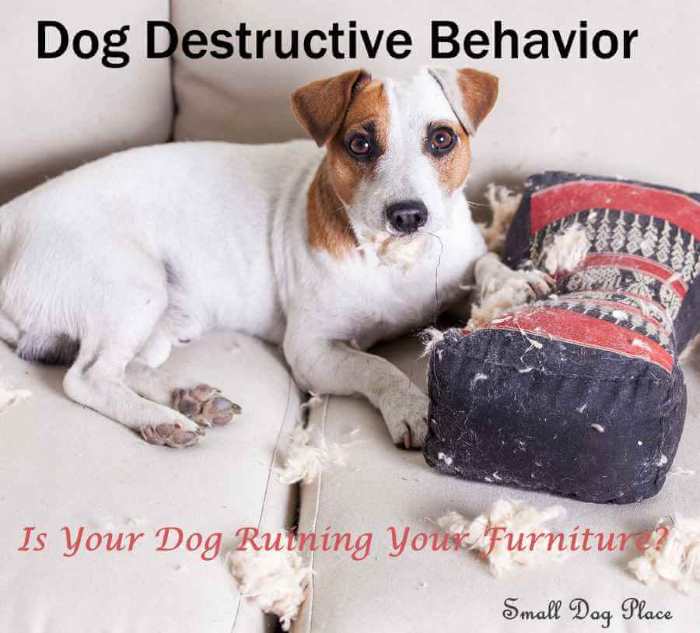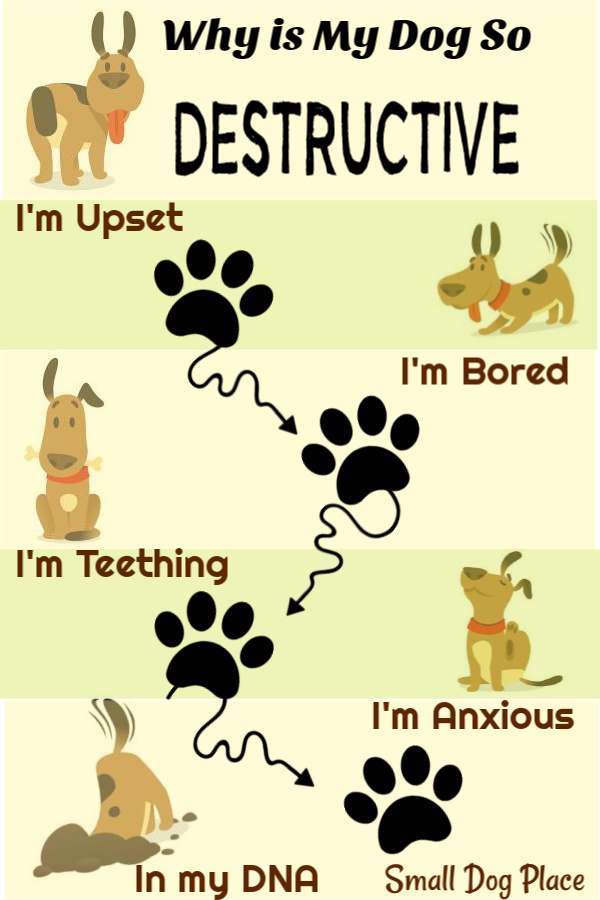Dog Destructive Behavior: Is Your Small Dog Ruining Your Furniture?
Dog Destructive Behavior By David Strickland |Updated January 30, 2020
A lot of things that your pup does is incredibly cute. However, one habit that you probably aren’t too happy with is their tendency to tear your furniture up when you aren’t around. This isn’t just an annoying practice – it can also be a rather expensive one to boot!
 Dog Destructive Behavior
Dog Destructive BehaviorThe good news is that you don’t have to put up with having your furniture in tatters. There are some tactics that you can use to correct this behavior. If you are interested in finding out just how to curb your pup’s unfortunate habits, this is what you need to do.
Identify the Causes of this Dog Destructive Behavior
Yes, sometimes it can seem like your small dog is gnawing on your furniture just to mess with you. Despite this, there is probably an underlying cause for this destructive behavior. Here are some of the most common culprits.
It Is In Their Nature
It can be easy to forget that our furry little friends were once wild creatures. So, even though they may enjoy snuggles and toys, some of that old DNA is still alive and kicking. This is especially true of certain dog breeds who were primarily bred to dig.
For instance, do you have a terrier, dachshund, or beagle? Well, then you will be less than pleased to learn that their ancestors spent quite a bit of their time digging. This could be why you keep coming home to dug up couches, carpets, and cushions.
Your Puppy is Teething
As with human babies, puppies teeth too and, your furry babies are bound to experience quite a bit of discomfort during this time.
Some of this pain can be relieved by chewing on various things – in this case, your furniture. If your puppy is six months or younger, this may be the top reason for their behavior.
Your Pooch is Upset
Dogs have a tendency to act out when they are scared, angry, or just plain frustrated. They will also do this if you have been gone for awhile and they are missing you. If they have a lot of nervous energy, one way they may try to alleviate it is by destroying your things.
Your Pup is Bored
Small dogs have a lot of energy – you know this. So, what happens if they aren’t given productive ways to work out all these wiggles? Well, they will find more destructive ways of dealing with the issue. In many instances, it is a lack of exercise that results in so much carnage.
How to Overcome These Dog Destructive Behaviors
Now that you have identified what the issues are let’s take a look at how you can overcome them. After all, once you have tackled the main problem, the resulting behavior is likely to go away.
Give Your Pup an Outlet to Minimize Dog Destructive Behavior
If your pup’s digging behavior is ingrained in them, there is a good chance that no amount of training may help. Fortunately, this doesn’t mean that all hope is lost. What you do need to do in this situation is to help them enact this behavior in a more contained manner.
In short, you should create an indoor digging pit for them. This is easy enough to build. All you need is a shallow container like a basin or dog bed. Then, cover this up with a blanket, cushions, and more bedding. Hide his or her favorite toys here and watch as they go at it.
To adequately curb the behavior, though, you are going to need to catch your dog in the act of digging at your furniture. When you notice this, just redirect your dog to their new digging spot. After a while, they should only head to the pit when they want to dig.
Minimize the Damage
While you are in the process of redirecting your puppy’s attention, it is a good idea to try and minimize the damage.
One of the ways to do this is by keeping their nails trimmed and rounded at all times. This way, even if they do dig at your cushions, the effect will be muted quite a bit.
So, you may want to add the best dog nail grinder to your list of things to buy.
Provide Your Pup with Teething Toys
If teething appears to be the primary cause of the destruction, some toys can help. By chewing on these instead, your pup will get the relief that he or she needs.
Once again, coating the toys in peanut butter or some other treat can encourage them to chew on the toy more often. If you are looking for a low-cost idea, some dogs love to crunch on ice cubes!
Deal With the Emotional Issues
If your pup is getting all worked up because he or she is being left alone, there are some tactics that you can use. To start with, try to make your exit a more favorable situation.
So, before you leave the house, make sure to toss your pooch a bone, treat, or toy. This should keep them busy for a while and make them feel less nervous about being alone.
In case you aren’t opposed to splurging a little, you may want to get a toy that allows you to dispense treats remotely. This way, you will be able to surprise your pup with their favorite snack during the middle of the day. Such an approach can help calm their nerves as well.
If you feel the situation is a bit more severe than this, you may need to call in the experts. Talk to your vet or consider hiring an animal trainer or behaviorist.
These professionals may be better equipped to deal with the issue and will often have a lot of useful advice to offer you.
Play With Your Pooch
There is no denying that life can be demanding and sometimes, you may not have as much time as you would like to play with your pups. Still, try to make an effort to provide them with exercise every day. Even if you can’t leave the house, play with them indoors.
Another great way to make sure that your pup is not bored is to get him or her to socialize with other dogs. This adds mental stimulation and can help take the edge off their boredom. If you really are pressed for time, see if there is a nearby doggy daycare that you can enroll your pup in.
Protect Your Furniture from Your Dog
Now, the above strategies are certainly going to work. However, they may take a while to kick in, and you are going to need some help until they do. So, here are a few ways that you can “dog proof” the furniture in your home:
Deter with Smell and Taste
Your pooch has a rather powerful snout and sense of taste, and you can actually use this against him or her. Some of the scents and tastes that your dog may not like include bitter apple, mouth wash, vinegar, and more. Lightly spray your furniture with these, and your pooch may not want to venture there. These products are not foolproof but they do reduce dog destructive behavior.
Cover the Furniture
These days, there are plenty of heavy-duty covers that you can place over your furniture. Just make sure that whatever you do drape over your couch and chairs stays put.
So, you may want to place solid objects to keep them in place. Also, make it a point to cover all of the areas that your dog typically likes to get.
Clean Your Couch
Do you snack on your couch? If so, there is a good chance that some of these tasty morsels end up in the couch cushions. This can lead to Fido trying to dig them out when they are hungry.
To avoid this situation, remove all the pillows and vacuum your furniture thoroughly.
Use an Alarm
If you don’t mind going the extra mile, then you may want to buy an alarm that gets triggered by sudden movement. Place this in a spot near furniture that your dog likes to tear up.
So, the next time he or she jumps there, the alarm will be activated. As you can imagine, this is only a suitable option when you are at home to turn the alarm off. After some time, though, your pup may be reluctant to jump on the furniture again.
Prevent Dog Destructive Behavior by Limiting Entry into Rooms
If possible, you should try setting up a dog (or baby) gate to block all the entry points into your living room. This way, your pup will not be able to reach the furniture to attack it.
The main reason most people don’t like this option is that these gates can be rather unsightly.
Dog Destructive Behavior Takeaway
The good news for you is that there is a lot you can do to stop your dog from destroying your furniture. Sure, it may take some time, patience, and innovation on your part but you will get there.
Until then, remember to always be kind to your dog, even when he or she has destroyed something valuable. Make sure to retrain them with love rather than anger. This approach will be healthier for you and your dog.
Author Bio: David Strickland (Dog Destructive Behavior)
David Strickland grew up with dogs of all breeds and sizes running around his home. It was during these years that he gained quite a bit of experience in raising and training all kinds of pups.
Eventually, this led to his passion project and the creation of the website Furry Tips. Currently, he is a dad to two fur baby Siberian Huskies but is always looking to make his family a bit bigger.
About Janice (author and voice behind this site)
Having lived with dogs and cats most of her life, Janice served as a veterinary technician for ten years in Maryland and twelve years as a Shih Tzu dog breeder in Ohio.
Her education includes undergraduate degrees in Psychology with a minor in biology, Early Childhood Education, and Nursing, and a master's in Mental Health Counseling.
She is a lifelong learner, a dog lover, and passionate about the welfare of animals. Her favorite breed for over 50 years has been the Shih Tzu, but she has also lived with Poodles, Maltese, Yorkshire Terriers, Beagles, English Bulldogs, Carin Terriers, and a Cocker Spaniel.
When not writing, reading, and researching dog-related topics, she likes to spend time with her eight Shih Tzu dogs, husband, and family, as well as knitting and crocheting. She is also the voice behind Miracle Shih Tzu and Smart-Knit-Crocheting
Does This Article Deserve Your Thumbs Up?
We always appreciate your support and encouragement. Your thumbs up means so much to us. Please like this article.
If you find this page or any page on Small Dog Place Helpful, or useful in anyway, I'd love it if you would click the small heart found on the bottom right of each page.
You can also share or bookmark this page -- just click on the:

Free Monthly Newsletter
Sign Up for Our Free Newsletter and get our Free Gift to You.
my E-book, The Top 10 Mistakes People Make When Choosing a Dog (and how to avoid them)


